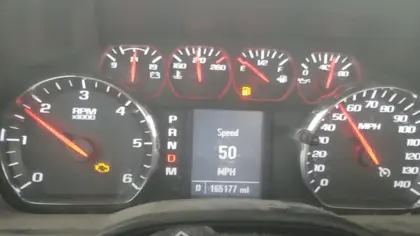It is very frustrating when your car won’t accelerate past 2500 RPMs. You are driving along and all of a sudden your car starts to slow down and won’t go any faster no matter how much you press the accelerator. This can happen for a number of reasons and it is important to figure out what is causing the problem so you can get it fixed.
Related Article: Car Doesn’t Slow Down When Foot Off Accelerator
Why Is My Car’s Acceleration Limited to 2500 RPMs?

If you own a car, you’re probably familiar with the RPM gauge on the dash. It’s a measure of how fast the engine is spinning and, in most cases, the needle should be hovering around the 1,500 to 2,500 mark while you’re driving. But what happens if it suddenly drops to 2,000 or worse, 1,500? And why is there a limit to how high it can go in the first place?
The answer has to do with your car’s engine and the way it’s designed to work. Most engines have what’s called a redline, which is the maximum RPM they can safely reach before things start breaking. For most cars, that redline is somewhere between 5,500 and 6,500 RPMs.
But why can’t we just rev the engine up to the redline and keep it there? After all, race cars do it all the time.
The problem is that engines are designed to run at a specific RPM range, and that range is usually much lower than the redline. That’s because the higher the RPM, the more stress is placed on the engine components. At lower RPMs, the engine is able to run more smoothly and with less wear and tear.
Think of it this way: if you were to run a marathon, you’d want to pace yourself so that you didn’t burn out halfway through. The same is true for your car’s engine. If you rev it up to the redline and keep it there, you’re going to cause a lot of wear and tear on the engine components. Eventually, something is going to break.
So, if you’re driving along and you suddenly notice that the RPM gauge is dropping, it’s probably because the engine is no longer able to maintain that high RPM. It could be because of a problem with the fuel system, the ignition system, or something else entirely. In any case, it’s best to get the car checked out by a mechanic to diagnose the problem.
As for the limit on how high the RPM gauge can go in the first place, that’s there to prevent you from accidentally redlining the engine. If the needle went all the way to the redline, it would be very easy to mistakenly keep the engine revved up at that high RPM, which would eventually cause damage.
To narrow down the discussion, your car won’t accelerate past 2500 RPMs because of limp mode. Limp mode is shown on the car dashboard when your car’s engine is having trouble operating. And to reduce the risk of engine damage car’s computers reduce car power which is called limp mode. As not every car has limp mode we described this manually at the beginning.
Is It Safe to Drive a Car That Won’t Accelerate Past 2500 RPMs?

As we mentioned before, most engines have a redline, which is the maximum RPM they can safely reach before things start breaking. For most cars, that redline is somewhere between 5,500 and 6,500 RPMs. However, engines are designed to run at a specific RPM range, and that range is usually much lower than the redline.
If you were to rev the engine up to the redline and keep it there, you would cause a lot of wear and tear on the engine components. Eventually, something would break. That’s why the RPM gauge is limited to 2500 RPMs. It’s there to prevent you from accidentally redlining the engine and causing damage.
Of course, if the RPM gauge drops suddenly and significantly, it’s best to get the car checked out by a mechanic. But if it only happens occasionally and the needle doesn’t drop too far, there’s no need to worry. Your car is just doing its job and protecting itself from damage.
So, the next time you’re driving and you notice the RPM gauge starts to drop, don’t panic. It’s probably just the engine protecting itself from damage. But if it happens repeatedly or if the needle drops suddenly and significantly, it’s best to get the car checked out by a mechanic.
Frequently Asked Questions
1. How Does a Car Act With Transmission Problems?
A car with transmission problems may act like a nightmare. The car may have trouble shifting gears, or it may slip out of gear while driving. The car may also make strange noises, or the transmission may feel “sluggish.” If you’re having transmission problems, it’s best to take your car to a mechanic for a diagnosis.
2. What Causes Reduced Engine Power?
There are many possible causes of reduced engine power, including a problem with the fuel system, the ignition system, or the engine itself. If your car is having trouble accelerating, it’s best to take it to a mechanic for a diagnosis.
3. Why Does My Car Get to High Rpms but Doesn’t Accelerate?
There are many potential causes for a car to get to high RPMs but not accelerate. Some of the most common causes include a problem with the spark plugs, a clogged fuel filter, or a problem with the mass air flow sensor.
4. How Do I Get My Car Out of Limp Mode?
To get your car out of limp mode, you’ll need to find the cause of the problem and fix it. This could be a problem with the transmission, the engine, or the exhaust system. If you’re not sure what’s causing the problem, it’s best to take your car to a mechanic for a diagnosis.
5. How Do You Know if Your Transmission is Failing?
If your transmission is failing, you may notice that the car has trouble shifting gears, or that it slips out of gear while driving. The car may also make strange noises, or the transmission may feel “sluggish.” If you’re having transmission problems, it’s best to take your car to a mechanic for a diagnosis.
6. Why is My Car Revving High but Going Slow?
There are several reasons why a car would rev high but go slow. The most common reason is that the car is low on power and the engine is working hard to try to get the car moving. Another reason could be that the transmission is not shifting properly, causing the engine to rev high without the car moving much.
Also Read: Why Does My Car Go Into Gear But Not Move?
The Bottom Line
Most car engines have a redline, which is the maximum RPM they can safely reach before things start breaking. However, engines are designed to run at a specific RPM range, and that range is usually much lower than the redline. That’s because the higher the RPM, the more stress is placed on the engine components.
If you’re driving and you suddenly notice that the RPM gauge is dropping, it’s probably because the engine is no longer able to maintain that high RPM. It could be because of a problem with the fuel system, the ignition system, or something else entirely. In any case, it’s best to get the car checked out by a mechanic to diagnose the problem.

